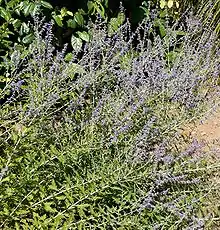| Salvia subg. Perovskia | |
|---|---|
 | |
| Salvia × floriferior 'Blue Spire' | |
| Scientific classification | |
| Kingdom: | Plantae |
| Clade: | Tracheophytes |
| Clade: | Angiosperms |
| Clade: | Eudicots |
| Clade: | Asterids |
| Order: | Lamiales |
| Family: | Lamiaceae |
| Tribe: | Mentheae |
| Genus: | Salvia |
| Subgenus: | Salvia subg. Perovskia (Kar.) J.B.Walker, B.T.Drew & J.G.González[1] |
Salvia subgenus Perovskia is a group of species within the flowering plant genus Salvia, which prior 2017 were treated as the separate genus Perovskia.[2] Members of the group are native to southwestern and central Asia.[3][4] It includes the garden plant Russian sage (Salvia × floriferior).[5]
The subgenus and former genus are named after the Russian general V. A. Perovski (1794-1857).[6]
- Species[7]
- Salvia abrotanoides (Kar.) Systma – Tibet, Kyrgyzstan, Turkmenistan, Afghanistan, Iran, Pakistan, western Himalayas of northern India
- Salvia bungei J.G.González, formerly Perovskia virgata Kudrjasch. – Tajikistan
- Salvia karelinii J.B.Walker, formerly Perovskia angustifolia Kudrjasch. – Kyrgyzstan, Tajikistan
- Salvia klokovii J.B.Walker, formerly Perovskia linczevskii Kudrjasch. – Tajikistan
- Salvia kudrjaschevii (Gorschk. & Pjataeva) Systma – Kyrgyzstan, Kazakhstan
- Salvia pobedimovae J.G.González, formerly Perovskia botschantzevii Kovalevsk & Kochk. – Kyrgyzstan, Tajikistan, Afghanistan
- Salvia scrophulariifolia (Bunge) B.T.Drew – Kyrgyzstan, Tajikistan
- Salvia yangii B.T.Drew – Afghanistan, Pakistan, western Himalayas, Tibet, Xinjiang
- Hybrids[7]
Cultivation
Plants in cultivation are almost all hybrids, including Salvia 'Blue Spire', which is very likely Salvia × floriferior, a naturally occurring hybrid between the entire-leaved Salvia yangii and Salvia abrotanoides. The leaves of this breed have long narrow teeth (i.e. are laciniate), unlike S. yangii which has entire leaves with shallow teeth.[5][8]
References
- ↑ "Genus: Perovskia Kar". Germplasm Resources Information Network. United States Department of Agriculture. 2004-09-10. Retrieved 2010-11-15.
- ↑ Drew, B.T., González-Gallegos, J.G., Xiang, C.L., Kriebel, R., Drummond, C.P., Walked, J.B. and Sytsma, K.J., 2017. Salvia united: The greatest good for the greatest number. Taxon, 66(1), pp.133-145.
- ↑ Kew World Checklist of Selected Plant Families
- ↑ Flora of China Vol. 17 Page 222 分药花属 fen yao hua shu Perovskia Karelin, Bull. Soc. Imp. Naturalistes Moscou. 14: 15. 1841.
- 1 2 Seneta W, Dolatowski J, Zieliński J. Dendrologia, ed. 13, p.730.
- ↑ Gledhill, D. (2008). The Names of Plants (4 ed.). Cambridge University Press. p. 297. ISBN 978-0-521-86645-3.
- 1 2 "Plants of the World Online Species Records of Perovskia". Retrieved 2010-08-01.
- ↑ Phillips, Roger & Rix, Martyn (1993). "Perovskia 'Blue Spire'". Perennials : Volume 2 Late Perennials. London: Pan Books. p. 213. ISBN 978-0-330-32775-6.
External links
![]() Media related to Perovskia at Wikimedia Commons
Media related to Perovskia at Wikimedia Commons
![]() Data related to Perovskia at Wikispecies
Data related to Perovskia at Wikispecies